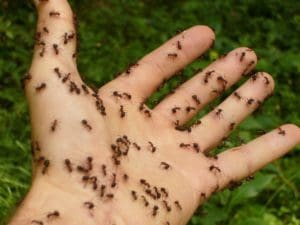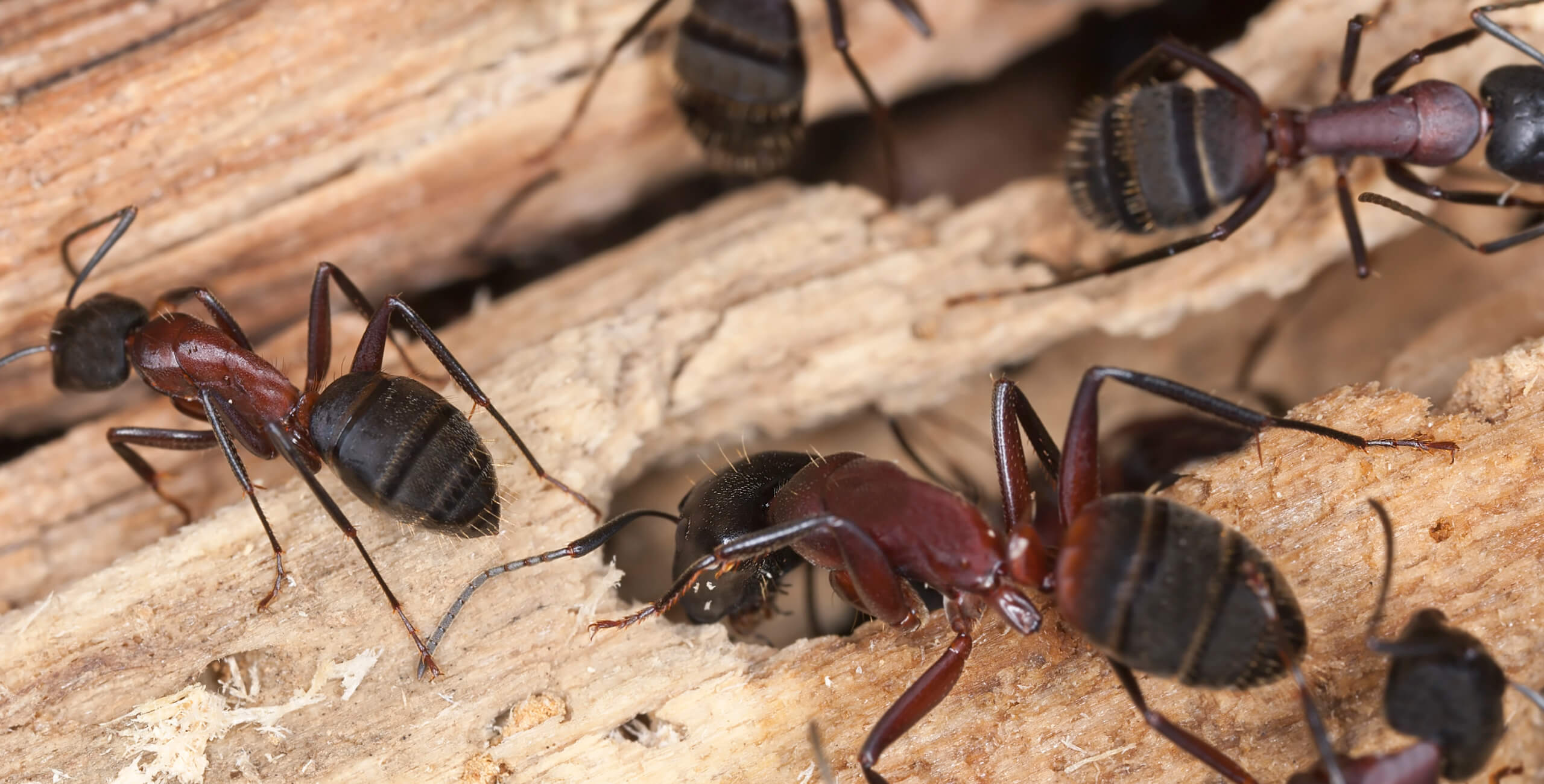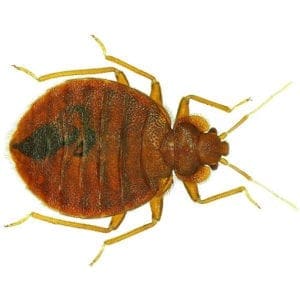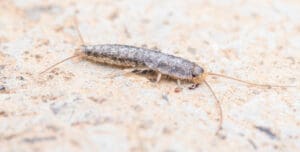

If left unchecked, carpenter ants can cause serious damage to your property. While carpenter ants don’t eat wood like termites, they do tunnel through wood in order to build nests.
In this article, we take a look at tips for preventing carpenter ant infestations in your home and how you can protect your property from costly structural damage due to these tiny yet powerful, insects.
How to Identify Carpenter Ants and Their Nests
Carpenter ants are large ants with black and reddish coloring.Adult carpenter ants range from ¼ inch to ½ inch in length and the carpenter ant queen is the largest.
Carpenter ant bodies are essentially segmented and have a constriction between the abdomen and the thorax. Their bodies are segmented and have a noticeable constriction between the thorax and abdomen. They also have strong antennae, and often appear to have a smooth, rounded thorax, which sets them apart from termites.
As stated previously and unlike termites, carpenter ants don’t consume wood. Rather, they build tunnels through wood in order to build their nests. The tunnels carpenter ants create are smooth, and wider and deeper than that of termite tunnels.
If you think you may have a carpenter ant infestation, signs to look out for include the presence of frass near wooden structures, rustling sounds from inside walls and any sighting of winged ants - winged ants are usually seen when they swarm a property in order to create new colonies. Another important warning sign is the discovery of holes in wood that will often appear in structural areas like beams or window frames. These nests are usually found in damp or rotting wood, as it is easier for ants to tunnel through than dry wood.
What Attracts Carpenter Ants to Your Home?
Mostly, carpenter ants invade homes in search of food, moisture, and shelter. Their key motive is to create a nest, which requires a consistent source of moisture and a safe, dark environment to thrive.
Decaying or damp wood is particularly attractive to carpenter ants because it is easier for them to tunnel through than dry wood. Homes with existing moisture issues or homes with high humidity, provide the ideal conditions for carpenter ants.
In addition to the above, carpenter ants are also drawn to homes because of the availability of food. Carpenter ants are actually omnivores and feed on a variety of substances. With this in mind, if they find crumbs, spilled sugar, or even pet food in your home, they will ultimately establish trails leading to these food supplies. They are particularly attracted to sugary substances, like honey or syrup, and will often forage in kitchens or pantries.
Wood damage is another element that can entice carpenter ants into your home. If a structure has weakened or damaged wood, carpenter ants see it as an opportunity to establish a nest - and if these conditions persist, the infestation can worsen.
Moisture issues, wood damage, and available food sources create the ideal environment for carpenter ants to invade a home - and thrive.
Preventing Future Carpenter Ant Infestations
Preventing a carpenter ant infestation involves addressing factors that make your home an attractive environment for them. Here are several strategies that can help keep these pests at bay:
- Repair water leaks: Carpenter ants are drawn to moisture, so fixing leaks in pipes, roofs, and windows is crucial. Check for signs of water damage in walls, ceilings, and under sinks. Even small leaks can create an ideal environment for ants to establish nests.
- Seal entry points: Carpenter ants can enter through tiny cracks and gaps around windows, doors, and foundations. Inspect the exterior of your home for potential entry points, such as gaps around utility lines or cracks in the siding. Use caulk or weatherstripping to seal these openings.
- Keep wood away from home foundations: Store firewood, mulch, and lumber at least 20 feet away from the foundation of your house. Carpenter ants are attracted to moist, decaying wood, so keeping wood piles away from your home reduces the likelihood of ants being drawn to your property.
- Trim trees and shrubs: Branches that touch your home can provide a direct route for ants to enter. Keep trees and shrubs well-trimmed and ensure they don’t touch the exterior of the house, as ants can use these branches as highways into your home.
- Maintain proper drainage: Ensure that gutters and downspouts are clear and direct water away from the foundation of your house. Poor drainage can lead to moisture buildup near the base of the home, creating a perfect environment for carpenter ants.
- Eliminate wood rot: If you notice any rotting or damaged wood around your home, replace or treat it promptly. Carpenter ants often nest in decaying wood, and even slight damage to your home’s wooden structure can attract them.
- Regular inspections: Conduct periodic inspections of your home’s wooden structures, especially areas that are prone to moisture, such as basements, crawl spaces, and attics. Early detection of any problems can prevent a full-blown infestation.
DIY Methods to Get Rid of Carpenter Ants
Carpenter ant pest control requires a mix of natural and tailored pest management solutions to effectively address both the ants you can see and the colony hidden inside your home.
Natural solutions, such as essential oils, are always a good starting point. Essential oils like peppermint, tea tree, and cinnamon have strong scents that ants find unpleasant. By mixing a few drops of essential oil with water and a small amount of dish soap to help the mixture stick, you can spray it directly along ant trails, in areas where they are entering, or near potential nests.
Vinegar is another effective natural solution that disrupts the ants' scent trails, making it harder for them to navigate. A mixture of water and vinegar, sprayed in areas where ants are active, can help deter them from returning.
Many people turn to insecticidal sprays that often contain pyrethrin, which can provide immediate relief by killing visible ants on contact. However, these sprays typically do not address the source of the infestation, so they should be part of a broader strategy that includes finding and treating the nest.
Professional Treatment Options for Carpenter Ants
While many smaller carpenter ant infestations can be controlled with home remedies or store-bought solutions, there are situations where it becomes necessary to call pest control experts, particularly when dealing with large infestations or nests that are hidden within walls.
DIY methods may not be sufficient to eliminate the colony. Even if you are able to remove the ants that are visible, the nest could persist inside the structure, leading to further damage and more ants emerging. If the infestation is hidden inside walls, locating and treating the nest can be nearly impossible without specialized equipment and knowledge.
Pest control experts have the tools to detect hidden nests, including moisture meters and infrared cameras, which can help pinpoint the exact location of the colony within your home’s structure.
The Twin-Boro team understands that while small carpenter ant issues may be addressed with DIY methods, hidden or larger infestation and prevention methods require professional intervention.
If you're considering professional treatment for carpenter ants, Twin Boro offers a tailored pest control solution that includes inspection, targeted treatment, and prevention strategies to ensure the elimination of ant colonies from your property
Protecting Your Home from Carpenter Ants for Good
Effective carpenter ant control relies on proactive measures such as sealing entry points, repairing water leaks, and maintaining proper drainage. Long-term prevention is key to avoiding future infestations. For comprehensive residential pest control solutions, contact us today to ensure your home remains safe and free from carpenter ants.






